Table of Contents:PREAMBLE
- INTRODUCTION
- BACKGROUND
- National, International and Provincial Context
- Legislative Authority for the Stewardship/Conservation of
 (Race Rocks) (Race Rocks)
- Marine Protected Area Strategy
 – A Place of Many Values – A Place of Many Values
- Conservation Interests
- Historic Interests
- Socio-economic Interests
- PROPOSAL FOR
 (RACE ROCKS) MARINE PROTECTED AREA (RACE ROCKS) MARINE PROTECTED AREA
- Process
- Issues Raised During Consultation
- A Vision for
 (Race Rocks) Marine Protected Area (Race Rocks) Marine Protected Area
- Objectives for
 (Race Rocks) Marine Protected Area (Race Rocks) Marine Protected Area
- Proposal to Designate
- Name
- Area Boundaries
- Designation
- Management Intentions
- Post Designation
LIST OF APPENDICES
I–Canada/BC Marine Protected Area Strategy MPA CriteriaII–IUCN Management Categories for Marine Protected Areas
III–Assessment of known conservation (Table 1) and socio-economic (Table 2) values in (Race Rocks) Marine Protected Area according to IUCN criteria for the identification and selection of marine protected areas
IV–Consultative Process
V–Guiding Principles for Designation of Race Rocks Ecological Reserve as a Marine Protected Area
VI–Maps
VII–Bibliography
PREAMBLE
The purpose of this proposal is to demonstrate that the criteria outlined in the draft Canada/British Columbia Marine Protected Area Strategy for Canada’s Pacific Coast (Appendix I) for establishing marine protected areas have been met, thereby providing the rationale for proceeding with formal designation of Race Rocks Marine Protected Area under the Oceans Act. Such designation will compliment the protected status of the existing provincial Ecological Reserve. In addition, designation of Race Rocks Marine Protected Area will also contribute to the World Conservation Union (IUCN) World Commission on Protected Areas initiative to create and manage a network of marine protected areas.
1.0 INTRODUCTION
In 1998, the Minister of Fisheries and Oceans announced four pilot Marine Protected Area initiatives on Canada’s Pacific coast. One of these areas was  (pronounced “shwai’yen” (Race Rocks) (Appendix VI). Since then, a wide range of further studies and consultations has been undertaken to determine the feasibility of proceeding to final designation of this unique area under the Oceans Act. (pronounced “shwai’yen” (Race Rocks) (Appendix VI). Since then, a wide range of further studies and consultations has been undertaken to determine the feasibility of proceeding to final designation of this unique area under the Oceans Act.
Located at the eastern entrance of Juan de Fuca Strait,  (Race Rocks) with its small rocky island system and high-current subtidal and intertidal areas is ecologically unique. The area contains ecologically significant and unique assemblages of benthic and pelagic invertebrates and provides haulout and feeding areas for California and Stellar sea lions during the winter. It is also the largest haulout and breeding areas for harbour seals in the Strait of Juan de Fuca, and provides nesting habitat and resting areas for migratory seabirds. (Race Rocks) with its small rocky island system and high-current subtidal and intertidal areas is ecologically unique. The area contains ecologically significant and unique assemblages of benthic and pelagic invertebrates and provides haulout and feeding areas for California and Stellar sea lions during the winter. It is also the largest haulout and breeding areas for harbour seals in the Strait of Juan de Fuca, and provides nesting habitat and resting areas for migratory seabirds.
Race Rocks has been managed as a provincial marine protected area for the past 20 years. The natural values of the  (Race Rocks) area were recognized formally by the Province of British Columbia in 1980 in its designation of the area as an Ecological Reserve under the provincial Ecological Reserves Act. This designation provides for protection of the natural and cultural heritage values of the terrestrial (nine islets) and the ocean bottom (to a depth of 20 fathoms) lands. (Race Rocks) area were recognized formally by the Province of British Columbia in 1980 in its designation of the area as an Ecological Reserve under the provincial Ecological Reserves Act. This designation provides for protection of the natural and cultural heritage values of the terrestrial (nine islets) and the ocean bottom (to a depth of 20 fathoms) lands.
 (Race Rocks) is located 17 kilometres southwest of Victoria, and is the most southerly part of Canada’s Pacific Coast. One of its nine islets is the site of Race Rocks lightstation, the second oldest lighthouse in Western Canada. (Race Rocks) is located 17 kilometres southwest of Victoria, and is the most southerly part of Canada’s Pacific Coast. One of its nine islets is the site of Race Rocks lightstation, the second oldest lighthouse in Western Canada.
The area’s remarkable tidal flow – up to seven knots – supplies a generous stream of nutrients to a thriving community of subtidal invertebrates, including sponges, anenomes, hydroids and soft corals. Crowds of barnacles, tunicates, urchins and sea stars adorn the underwater cliffs. Fish such as sculpin, rockfish and lingcod seek refuge in the rocky crevices and undulating kelp forests. Above water, the islets serve as nesting colonies for many seabirds, such as gulls, cormorants, pigeon guillemots and oystercatchers, and as a
stopover for migratory birds. They share the rocks with resting harbour seals, Stellar and California sea lions, and a few Northern Elephant seals. River otters patrol the shoreline and killer whales are frequent visitors. Gray whales, Dall’s and harbour porpoises occasionally pass by.
The  (Race Rocks) area is traditional territory for at least four Coast Salish First Nations people; Beecher Bay, T’souke, Songhees and Esquimalt. The nutrient rich waters provided a wide diversity of food fishing opportunities year round. The Coast Salish people’s interaction with the (Race Rocks) area is traditional territory for at least four Coast Salish First Nations people; Beecher Bay, T’souke, Songhees and Esquimalt. The nutrient rich waters provided a wide diversity of food fishing opportunities year round. The Coast Salish people’s interaction with the  area has been based on the First Nations “Thirteen Moons” calendar; a spiritual and temporal-based approach to sustainably harvesting and respecting the area has been based on the First Nations “Thirteen Moons” calendar; a spiritual and temporal-based approach to sustainably harvesting and respecting the  resources. resources.
The exceptional diversity of marine life at  (Race Rocks) – long recognized by First Nations in the area – makes it an ideal place for scientific and educational observation. It serves as a model for the transition zone between inner coastal waters and the open ocean, which is why nearby Lester B. Pearson College has supported the stewardship and protection of the area. In accordance with the management objectives for the Ecological Reserve, BC Parks is proposing to operate the lightstation facility as a research/education/guardian centre. It is proposed that Lester B. Pearson College will provide this service, under permit to BC Parks. (Race Rocks) – long recognized by First Nations in the area – makes it an ideal place for scientific and educational observation. It serves as a model for the transition zone between inner coastal waters and the open ocean, which is why nearby Lester B. Pearson College has supported the stewardship and protection of the area. In accordance with the management objectives for the Ecological Reserve, BC Parks is proposing to operate the lightstation facility as a research/education/guardian centre. It is proposed that Lester B. Pearson College will provide this service, under permit to BC Parks.
Designation as a Marine Protected Area under the Oceans Act will be followed by a further consultation process leading to the preparation of a long-term integrated management plan for the joint federal/provincial marine protected area under the direction of Fisheries and Oceans Canada and BC Parks.
2.0 BACKGROUND:
2.1-International, National and Provincial Context
Canada and British Columbia are committed to the protection of marine biodiversity and ecological processes, and the sustainable use of marine resources. The commitment to establish Marine Protected Areas fulfils Canada’s international responsibilities and obligations to the United Nations Convention on the Law of the Sea (UNCLOS) and as a signatory to the Convention on Biological Diversity (UNEP 1994) and the major components of the Jakarta Mandate developed under that Convention. This commitment also provides a means of meeting obligations under the Convention on Migratory Species (Bonn Convention).
This commitment is reinforced by a national Fisheries and Oceans Canada policy for establishing Marine Protected Areas. This policy aims to establish a system of Marine Protected Areas under the Oceans Act throughout Canada’s oceans to protect areas that are examples of the major ecological regions and the communities of plants and animals they contain. Supported by a range of provincial and federal marine-related legislation and policy responsibilities, the Federal Committee on Oceans (Pacific Region and National) provides advice and input to assist in the co-ordination and integration of Marine Protected Area proposals at the broader regional and national level.
Section 35 of the Oceans Act specifically provides for the Minister of Fisheries and Oceans to establish Marine Protected Areas. The commitment of this Act and associated policy supports the above international responsibilities and obligations in addition to the World Conservation Union (IUCN) World Commission on Protected Areas program of promoting the establishment and management of a global representative system of Marine Protected Areas (Kelleher et al 1995). Appendix II lists the internationally accepted IUCN management categories for protected areas. These management categories were developed by the IUCN with input from agencies with protected area responsibilities from around the world to promote a consistent approach to protected area management. It is proposed that this MPA will have an appropriate management category assigned to it as part of the preparation, with stakeholders, of the management plan.
 (Race Rocks) has been assessed against the IUCN’s and World Commission of Protected Areas (WCPA) criteria for selection and identification of Marine Protected Areas (see Appendix III for summaries of these assessments). (Race Rocks) has been assessed against the IUCN’s and World Commission of Protected Areas (WCPA) criteria for selection and identification of Marine Protected Areas (see Appendix III for summaries of these assessments).
2.2 -Legislative Authority for designation and management of  (Race Rocks)Stewardship of the (Race Rocks)Stewardship of the  (Race Rocks) area is entrusted to all Canadians. To ensure that the interests of all Canadians are fairly represented in management processes for the area, three lead steward groups will oversee the management of the (Race Rocks) area is entrusted to all Canadians. To ensure that the interests of all Canadians are fairly represented in management processes for the area, three lead steward groups will oversee the management of the  (Race Rocks) area. The tri-partied management of (Race Rocks) area. The tri-partied management of  will be comprised of the Coast Salish First Nations people; the provincial government through the Ministry of Environment, Lands and Parks; and the federal government through Fisheries and Oceans Canada. The legislative authorities under which these stewards are mandated (acknowledged) are as follows: will be comprised of the Coast Salish First Nations people; the provincial government through the Ministry of Environment, Lands and Parks; and the federal government through Fisheries and Oceans Canada. The legislative authorities under which these stewards are mandated (acknowledged) are as follows:
First Nations:
Aboriginal title to traditionally used territories is recognized and affirmed as an ‘existing Aboriginal right’ in Section 35 of the Constitution Act, 1982. Aboriginal title is one manifestation of a broader-based conception of Aboriginal rights. Aboriginal title is based on occupation of traditional territory prior to the assertion of European sovereignty and takes into account the following aspects: right of exclusive use and occupation of the land; right to choose to what purposes the land can be put; and the economic aspect of the land. (Delgamuukw vs. British Columbia).
The Crown is required to give appropriate priority to Aboriginal interests in Aboriginal title lands, reflecting the exclusive nature of Aboriginal title. The Supreme Court has also affirmed the Crown’s obligation to accommodate participation by First Nations in decision-making with regard to development of lands subject to Aboriginal title.
The legal authority to establish a protected marine area flows from one or more provincial and federal statutes including: British Columbia’s Ecological Reserve Act, Park Act, Wildlife Act or Environment and Land Use Act, as well as the Fisheries Act of Canada, National Parks Act, Canada Wildlife Act, Migratory Birds Convention Act, Canada’s Oceans Act or the proposed new Marine Conservation Areas Act.
Fisheries and Oceans Canada has the mandate to manage specified marine resources under the Fisheries Act and the Oceans Act. Section 35 (2) of the Oceans Act states that the Minister of Fisheries and Oceans Canada has a responsibility “to lead and co-ordinate the development and implementation of a national system of Marine Protected Areas on behalf of the Government of Canada”.
Section 35 (1) of the Oceans Act authorizes the Government of Canada to establish Marine Protected Areas for a number of reasons, including the conservation and protection of:
- commercial and non-commercial fisheries, including marine mammals and their habitats;
- endangered or threatened species and their habitats;
- unique habitats;
- marine areas of high biodiversity or biological productivity; or
- any other marine resource or habitat as is necessary to fulfil the mandate of the Minister of Fisheries and Oceans.
British Columbia ecological reserves are established by provincial order-in-council under the Ecological Reserves Act for the:
- preservation of representative samples of British Columbia’s ecosystems;
- protection of rare and endangered plants and animals in their natural habitat;
- preservation of unique, rare or outstanding botanical, zoological or geological phenomena;
- perpetuation of important genetic resources; and
- scientific research and educational uses associated with the natural environment.
2.3-Marine Protected Area Strategy
The governments of Canada and British Columbia are working together to implement a Marine Protected Areas strategy that will achieve co-ordinated marine protection and
conservation goals for the Pacific coast. As mentioned earlier, one of these areas is  (Race Rocks). (Race Rocks).
The proposed designation of  (Race Rocks) as a Marine Protected Area exemplifies the essential elements of a viable west coast Marine Protected Area draft strategy (Marine Protected Area Strategy for Canada’s Pacific Coast) in that: (Race Rocks) as a Marine Protected Area exemplifies the essential elements of a viable west coast Marine Protected Area draft strategy (Marine Protected Area Strategy for Canada’s Pacific Coast) in that:
- It uses a joint federal-provincial approach: all relevant federal and provincial agencies will work collaboratively to exercise their authorities to achieve the full level of protection expected by the public for the area.
2.-It provides for shared decision-making with the public: commits government agencies to employ an inclusive shared decision-making process with First Nations, stakeholders, coastal communities and the public.3.-It contributes to a comprehensive marine protected area system: seeks to build an extensive system of protected areas by the year 2010 through a series of coastal planning processes.
4. The  (Race Rocks) area was selected as an MPA pilot under the federal provincial MPA Strategy initiative based on its status as a richly diverse and important ecosystem. Both levels of government recognized that the Oceans Act could provide new, complementary and longer-term opportunities for the protection of the Race Rocks Ecological Reserve. (Race Rocks) area was selected as an MPA pilot under the federal provincial MPA Strategy initiative based on its status as a richly diverse and important ecosystem. Both levels of government recognized that the Oceans Act could provide new, complementary and longer-term opportunities for the protection of the Race Rocks Ecological Reserve.
Past collaboration between Fisheries and Oceans Canada and BC Parks has yielded Fisheries Act closures within the reserve for most species since 1990. The creation of an Oceans Act MPA within the water column above the provincial Ecological Reserve will facilitate the integrated management of the  (Race Rocks) area under the respective authorities of the two levels of governments. (Race Rocks) area under the respective authorities of the two levels of governments.
Management planning processes provide a mechanism for public review and support for management strategies. In this respect it will be important that the proposed management plan for the joint Ecological Reserve – Marine Protected Area make appropriate linkages with other land use planning strategies.
3.0- (Race Rocks) – a place of many values (Race Rocks) – a place of many values
 (Race Rocks) is a place with many values. It is essential that these values be respected and managed holistically to enable optimum protection of (Race Rocks) is a place with many values. It is essential that these values be respected and managed holistically to enable optimum protection of  (Race Rocks). It is because of the array of natural, cultural heritage, and recreation values that complementary federal and provincial designations and management activities are required to achieve the level of protection expected by the public. (Race Rocks). It is because of the array of natural, cultural heritage, and recreation values that complementary federal and provincial designations and management activities are required to achieve the level of protection expected by the public.
These values have been categorized into three interest areas: Conservation, Cultural Heritage, and Socio-Economic.
While the Ecological Reserve and Marine Protected Area complement each other in contributing to the maintenance of biological diversity and the protection of genetic material, equally important is the historic significance of the area to First Nations people and mariners.
3.1-Conservation Values
The Ecosystem Overview of Race Rocks (Race Rocks Ecosystem Overview, G. Fletcher, 1999) and the Draft Management Plan for Race Rocks (BC Parks, 1998) identify a number of key conservation values for the  (Race Rocks) area which are outlined below. (Race Rocks) area which are outlined below.
Geology:
The geological terrain that includes Race Rocks is known as the Crescent Terrain, with the most prominent feature being the Metchosin Igneous Complex. This package of rocks are fine grained basalts (extrusive ocean crust) and their coarse grained equivalent, gabbros (intrusive rocks). Still evident are the small erratics and scour marks from the last of three glaciations.
Climate:
Located in the rain shadow of the Olympic Mountains and influenced by a wind funnel effect over the Strait of Juan de Fuca,  (Race Rocks) often experiences weather patterns quite different to southern Vancouver Island. It has an unusually high amount of sunshine in the winter months, very seldom recording freezing temperatures. In the summer, there is the occasional blanketing of fog. The winds in the Juan de Fuca Strait blow principally from the southeast and northwest. Outward blowing winds occur fifty percent of the time during the winter (October through to March) while the inward blowing winds predominate during the summer (April through to September). (Race Rocks) often experiences weather patterns quite different to southern Vancouver Island. It has an unusually high amount of sunshine in the winter months, very seldom recording freezing temperatures. In the summer, there is the occasional blanketing of fog. The winds in the Juan de Fuca Strait blow principally from the southeast and northwest. Outward blowing winds occur fifty percent of the time during the winter (October through to March) while the inward blowing winds predominate during the summer (April through to September).
Temperature and salinity:
Race Rocks lightstation staff have recorded salinity and temperature for the past sixty years, with some local records dating back to 1921. Salinity varies considerably and is seasonally affected by the large volumes of weakly stratified, freshwater from the Fraser River. Winter water temperatures average about 7.5° C. with summer peaks of about 11° C.
Physical oceanography:
The area features high velocity currents that can reach up to seven knots in some shallow rocky intertidal or subtidal locales. The currents create a turbulent regime that brings nutrients up from surrounding depths and thus support a highly localized and complex food web. The currents also mix the water column, inhibit stratification, and promote high dissolved oxygen and nutrient concentrations. Rocky intertidal and subtidal sites especially those with high current flow also attract many diverse species of fishes, marine mammals and seabirds and promote high levels of invertebrate larval recruitment.
Marine algae and vascular plants:
Forty-one taxa are found at Race Rocks. Approximately 50% of vegetation coverage consists of Brown Kelps in certain depths and months; 30-90% may be Coralline Algae in other locales. Their biomass may be significantly higher than in surrounding areas.
Phytoplankton and zooplankton:
Species information is available from collection stations in the Strait of Juan de Fuca, a highly dynamic but poorly studied area. About 130 known taxa of phytoplankton and 100 zooplankton occur. Diatoms are most abundant in spring and early summer; dinoflagellates high in later summer and early fall; microflagellates in winter. Chlorophyll ranges from 1 to 5 mg/m3, low in fall/winter, high in spring/summer. Calanoid copepods are a dominant group, up to 70 – 90% in spring and summer. Pseudocalanus are most common species in the Strait. Other important zooplankton include euphasids, arrow worms, and fish eggs and larvae. Zooplankton abundance reaches a high of about one million individuals per sq. metre in August.
Benthic Invertebrates:
Although the species list is incomplete, evidence indicates high abundance and species diversity with over 200 taxa listed. Germesia (soft-coral), Gorgonocephalus (brittle star), E. prolifera and M. senile (anemones) are extremely abundant. Pacific abalone is listed as threatened by the Committee on the Status of Endangered Wildlife in Canada (COSEWIC). Recent towed video surveys showed high occurrences of sea urchins and anemones.
Fishes:
Thirty-five species are found here. However, there are large knowledge gaps about the fish populations and their roles in this ecosystem. The area represents a critical habitat for many species of rockfish, lingcod, and kelp greenling. Some rockfish species are now considered a “Species of Concern” by Washington State (U.S.A.) and are of conservation concern in B.C.
Birds:
About 45 known species of marine associated birds use Race Rocks Area for feeding, roosting, and nesting. The area provides critical nesting habitat for Glaucous-winged Gulls, Pigeon Guillemots, Black Oystercatchers and possibly Brandt’s Cormorants. Twenty-three percent of the Pelagic Cormorant population in the eastern Strait of Juan de Fuca nests at Race Rocks.
Marine Mammals:
Species found at Race Rocks include five known species of pinnipeds and ten species of cetaceans, five of which are common. The area is primarily used as a stop-over and rafting site for California (>1,000) and Steller sea lions (>50) in the winter. Harbour seals are the primary year-round resident users for haulout, birthing, pupping, and weaning. Race Rocks is the largest haulout for harbour seals in the Strait of Juan de Fuca, the second largest in the Canadian waters of the Georgia Basin, and can represent up to 20% of the South Gulf Islands population.
3.2- Cultural Heritage Values
Traditional harvest:
Four Coast Salish First Nations, Beecher Bay, T’souke, Songees and Esquimalt Nations, claim the eastern end of the Strait of Juan de Fuca as part of their traditional territory. Other Coast Salish Nations may have used this area. Interviews with First Nations representatives indicate that a wide range of food was available from the coastal waters including gull’s eggs, sea cucumbers, sea urchins, chitons, snails, whelks, mussels, barnacles, seaweeds, crab and fish. Seafood was not only eaten but also traded with other First Nations including those from Washington State (U.S.A.).
Marine Navigation:
As part of the “Graveyard of the Pacific”, the area was named “Race Rocks” by officers of the Hudson’s Bay Company who noted the area as a severe hazard to navigation in the 19th century due to the dangers created by the rip tide. Numerous shipwrecks led to the establishment of a lighthouse station at Great Race Rock in 1860. This lighthouse is the second oldest on Canada’s West Coast and is protected with designation as a heritage structure. The Underwater Archaeological Society of British Columbia maintains an inventory of shipwreck sites within the Race Rocks Ecological Reserve.
3.3 -Socio-economic interests
The diversity and significance of natural, cultural heritage and recreational values of the Race Rocks area generates substantial and varied socio-economic interests. Under the provincial legislation however, there are significant limitations on the acceptable uses of the area. For instance, the primary purpose of the Ecological Reserve is the protection of the natural and cultural heritage values, and human use may only occur to the extent to which these values are not impaired. Ecological Reserves are not designated for recreational purposes. The socio-economic interests identified below should be considered in light of this restrictive legislation.
- Co-operation with First Nations:The
 (Race Rocks) pilot Marine Protected Area investigation and pre-designation process has provided a good opportunity to nurture significant relationships between all participants and improved understanding of First Nations’ interests (Appendix IV). The area has been a productive traditional use fishing area for First Nations. (Race Rocks) pilot Marine Protected Area investigation and pre-designation process has provided a good opportunity to nurture significant relationships between all participants and improved understanding of First Nations’ interests (Appendix IV). The area has been a productive traditional use fishing area for First Nations.
- Education and research:The biodiversity of the
 (Race Rocks) area has strong value for the local naturalist and science communities. Lester B. Pearson College of the Pacific, as an international school of choice for many foreign students, has been engaged for more than twenty-five years with the “ (Race Rocks) area has strong value for the local naturalist and science communities. Lester B. Pearson College of the Pacific, as an international school of choice for many foreign students, has been engaged for more than twenty-five years with the “ living classroom”; providing benefits to thousands of people of all ages and from more than a hundred countries. Through its interactive internet site, www.racerocks.com, the college is promoting awareness of the marine environment to an international audience.The faculty and students of the Biology and Environmental Systems program at Pearson College are long-time volunteer ecological reserve wardens. They are actively involved in research and education activities and provide an important monitoring function. The College has been the principal research agency to date and has developed an excellent database for the ecological reserve and its values. Numerous opportunities exist to involve the education and research community in creative joint educational initiatives with First Nations, BC Parks and Fisheries and Oceans Canada. living classroom”; providing benefits to thousands of people of all ages and from more than a hundred countries. Through its interactive internet site, www.racerocks.com, the college is promoting awareness of the marine environment to an international audience.The faculty and students of the Biology and Environmental Systems program at Pearson College are long-time volunteer ecological reserve wardens. They are actively involved in research and education activities and provide an important monitoring function. The College has been the principal research agency to date and has developed an excellent database for the ecological reserve and its values. Numerous opportunities exist to involve the education and research community in creative joint educational initiatives with First Nations, BC Parks and Fisheries and Oceans Canada.
- Eco-tourism:The following summarizes the forms of eco-tourism that currently occur in the Race Rocks area. It is recognized that these uses may be restricted as necessary to protect the natural and cultural heritage values of the area and ensure that these values are sustained.Marine wildlife viewing and diving are the predominant forms of eco-tourism in the Race Rocks area. As a result of a rapid and spontaneous growth of marine wildlife viewing in southern Vancouver Island, principally for orca whales, there has been increasing interest in Race Rocks for the diversity and availability of other marine mammals.British Columbia’s waters are renowned world-wide for their excellent diving value and Race Rocks exemplifies some of the world’s best diving opportunities. Strong currents, offer limited diving windows requiring experienced and “guided” diving. The dive industry is enjoying good growth and providing jobs and benefits to the tourism sector.
- Commercial Fishing:The area has been closed to commercial fishing for all species under the Fisheries Act since 1990.
- Recreational Fishing:Sport fishing for salmon and halibut is currently very popular in the area directly adjacent to the Race Rocks Ecological Reserve.
- Marine Navigation:Frequent heavy oil and crude tanker traffic (two supertankers per day on average) passes within two miles of the
 (Race Rocks) area. Recreational boating is somewhat limited because of tidal and current conditions. (Race Rocks) area. Recreational boating is somewhat limited because of tidal and current conditions.
- Mining and Petroleum:The authority for exploration for or extraction of any oil or gas reserves within the Georgia Region, including the
 (Race Rocks) area rests with the Province of British Columbia.Exploration and development of mineral and petroleum resources within the Race Rocks Ecological Reserve is prohibited under the British Columbia Ecological Reserve Act. (Race Rocks) area rests with the Province of British Columbia.Exploration and development of mineral and petroleum resources within the Race Rocks Ecological Reserve is prohibited under the British Columbia Ecological Reserve Act.
- Co-operation with non-government organizations:The process for consultations with stakeholders involved considerable and useful dialogue with non-government organizations. The volunteer Race Rocks Advisory Board (RRAB) included representation from the Canadian Parks and Wilderness Society, Georgia Strait Alliance and Friends of Ecological Reserves. As a result, all participants developed better understanding of interests, values and common objectives with the establishment of a marine protected area.
- Co-operation Between Governments:
BC. Parks, Parks Canada, the Department of National Defence and Fisheries and Oceans Canada are committed to a coordinated and cooperative approach to the management of Race Rocks and providing the level of protection identified by the public and the RRAB. This pilot process has led to a greater understanding and improved collaboration between these agencies.
4.0 Proposal for  (Race Rocks) Marine protected Area4.1-Process (Race Rocks) Marine protected Area4.1-Process
To assist Canada and B.C. in working towards the formal designation of the  (Race Rocks) Marine Protected Area under the Oceans Act, a multi-stakeholder Race Rocks Advisory Board was established in 1999. (Race Rocks) Marine Protected Area under the Oceans Act, a multi-stakeholder Race Rocks Advisory Board was established in 1999.
Membership on the Race Rocks Advisory Board was comprised of representatives from: Friends of Ecological Reserves, the local dive community, Georgia Strait Alliance, Pearson College, First Nations (Coast Salish Sea Council), Sport Fish Advisory Board – Victoria, Department of National Defence, Lester B. Pearson College of the Pacific, Parks Canada, the Canadian Parks and Wilderness Society, the local science community, Northwest Whale Watchers Association and Fisheries and Oceans Canada.
The function of the Advisory Board was to:
- represent key stakeholders and partners who would provide advice to Fisheries and Oceans Canada and BC. Parks on the consultation process;
- collate and analyze feedback from consultations;
- provide consensus-based, recommendations to Fisheries and Oceans Canada and BC Parks for the establishment of a Marine Protected Area at

(Race Rocks) and recommendations for management of the MPA; and,
ensure community involvement in the establishment and on-going management of the  (Race Rocks) Marine Protected Area. (Race Rocks) Marine Protected Area.
4.2 -A Vision for  (Race Rocks) Marine Protected Area (Race Rocks) Marine Protected Area
“Based on a cooperative and integrated, multi-lateral relationship, Race Rocks Marine Protected Area – Ecological Reserve will conserve and protect a unique, high-energy marine ecosystem for the benefit of future generations.”
Source: Stakeholder Consultations 1999/2000“Race Rocks Ecological Reserve will continue to protect the high energy marine system found in the eastern entrance of the Strait of Juan de Fuca.”
Source: Race Rocks Ecological Reserve, Draft Management Plan June 19984.3 Management Issues Raised During Consultation
Eco-tourism
As British Columbia’s eco-tourism and dive industries expand, it is anticipated that visits to  (Race Rocks) will increase over the next few years. This will necessitate the development of “best practices” to ensure that the feeding, resident and breeding species in the area are not disturbed. To date, there has been excellent co-operation from the marine mammal viewing industry towards the development and maintenance of guidelines for operating in the (Race Rocks) will increase over the next few years. This will necessitate the development of “best practices” to ensure that the feeding, resident and breeding species in the area are not disturbed. To date, there has been excellent co-operation from the marine mammal viewing industry towards the development and maintenance of guidelines for operating in the  (Race Rocks) area. Similarly, the dive industry has expressed strong interest in developing guidelines, training and stewardship models for managing activity within Marine Protected Areas. (Race Rocks) area. Similarly, the dive industry has expressed strong interest in developing guidelines, training and stewardship models for managing activity within Marine Protected Areas.
Any restrictions to recreational use will be made in consultation with the Race Rocks Advisory Board and the affected interest groups and others. For example, through the public advisory group process, and with the support of the whale watching industry, voluntary guidelines for appropriate viewing procedures have been established. As the popularity of viewing activities increases, this use will be monitored and further restrictions may be applied if impacts on the resources exceed acceptable limits.
Recreational Fishing
There are conservation concerns related to bycatch of species of concern such as rockfish and lingcod in the recreational salmon and halibut fisheries directly adjacent to the Race Rocks Ecological Reserve. The Race Rocks Advisory Board recommended that the area be closed to all fishing activity. Although initially reluctant to consider a total recreational fishing closure within the boundary of the proposed  (Race Rocks) Marine Protected Area, the Sport Fish Advisory Board (SFAB) now supports this recommendation. (Race Rocks) Marine Protected Area, the Sport Fish Advisory Board (SFAB) now supports this recommendation.
Recreational Boating
Proximity to a large population base and the geographic location of Race Rocks (transit between the “west coast” and Gulf Island communities) make the Marine Protected Area particularly vulnerable to boating use. The volume of traffic passing in close proximity to, or through the MPA, will likely continue to increase over time. This activity will need to be closely monitored and subject to marine safety considerations, further restrictions may be required if adverse impacts exceed acceptable limits.
Marine Navigation
Due to the isolated nature, and the small area encompassed by the Race Rocks Ecological Reserve and proposed Marine Protected Area, even a small oil spill could have a devastating impact on the Race Rocks area. Oil spill contingency resources are available in Victoria. There may be a requirement to consider special contingency arrangements during the development of the management plan for  (Race Rocks) Marine Protected Area due to the area’s high-energy environment. (Race Rocks) Marine Protected Area due to the area’s high-energy environment.
The Port of Vancouver’s draft Ballast Water Management Guidelines state that dumping of ballast water may take place west of the Race Rocks Ecological Reserve. The introduction of alien species and contamination could significantly impact the  (Race Rocks) environment. A monitoring regime to address the potential introduction of alien species will need to be considered through the Federal Committee on Oceans — Pacific during the development of the management plan. (Race Rocks) environment. A monitoring regime to address the potential introduction of alien species will need to be considered through the Federal Committee on Oceans — Pacific during the development of the management plan.
Federal Committee on Oceans (Pacific Region)
Members of the Federal Committee on Oceans (Pacific Region) were contacted by letter in mid-May to determine if there were any issues related to moving forward with designation of the Race Rocks MPA. No issues were raised.
4.4-Objectives for  (Race Rocks) Marine Protected Area (Race Rocks) Marine Protected Area
The following objectives have been identified for the Oceans Act portion of the joint marine protected area. These objectives may be modified following an integrated management planning process for the joint Federal-Provincial Marine Protected Area.
The objectives for the  (Race Rocks) Marine Protected Area are as follows: (Race Rocks) Marine Protected Area are as follows:
- To protect the conservation values associated with marine biological diversity, marine habitats and the marine ecosystem associated with the Race Rocks Ecological Reserve and surrounding waters (see Appendix III);
- To permit the awareness, appreciation, use and enjoyment of the Race Rocks area, its natural and cultural heritage values to the extent that these uses do not impact adversely on the values within the proposed Marine Protected Area;
- To support the sharing of traditional knowledge;
- To provide scientific research opportunities to further understanding of the area to the extent that the impact of these uses is within acceptable limits and do not impair the diversity, abundance and functioning of the marine ecosystem;
- To permit increased education and awareness of the marine environment to the extent that the impacts of these uses are within acceptable limits and do not impair the diversity, abundance and functioning of the marine ecosystem; and,
- To test Fisheries and Oceans Canada’s National Framework for Establishing and Managing Marine Protected Areas and the Canada/BC Marine Protected Areas Strategy for Canada’s Pacific Coast.
4.5-Proposal to designate
The recommendations, outlined below, reflect the outcome of a consensus-based process by the Race Rocks Advisory Board (RRAB) regarding the management of the  (Race Rocks) area as an MPA. These recommendations also reflect the directions expressed by the public, stakeholders and other partners, through consultations over the past two years, in support of complementary management of the Race Rocks Ecological Reserve as a Marine Protected Area. (Race Rocks) area as an MPA. These recommendations also reflect the directions expressed by the public, stakeholders and other partners, through consultations over the past two years, in support of complementary management of the Race Rocks Ecological Reserve as a Marine Protected Area.
Over the past eighteen months, the pilot Marine Protected Area process has identified and galvanized strong support for the complementary designation of Race Rocks as a joint MPA under federal and provincial jurisdictions. The consultative process developed new, trust-based relationships between an array of stakeholders and user groups including First Nations, sports fishers, eco-tourism companies, dive charter operators, scientists, educators and environmental organizations. It also elevated expectations that federal follow-through will be expeditious. There is significant risk to these valuable relationships and stakeholders’ reputations should the designation be delayed.
The following recommendations for the area’s management are presented for consideration:
4.6 a-Designation
It is recommended that Race Rocks be a joint federal-provincial marine protected area, receiving a high level of protection through the complementary authorities of the Federal Oceans Act and the Provincial Ecological Reserve
Act.
4.6 b-Co-operative Management
It is recommended that a joint Management Committee consisting of First Nations, Fisheries and Oceans Canada and BC Parks be established to ensure that the planning and management of the area is co-ordinated, effective and efficient and that Fisheries and Oceans Canada and BC Parks, as the lead public agencies, are publicly accountable for achieving the area’s goals and objectives.
4.6 c-Name
It is recommended that the Marine Protected Area be named  (Race Rocks) in respect for the Coast Salish Nations name in the Clallam language, which is translated as meaning “fast flowing waters”. (Race Rocks) in respect for the Coast Salish Nations name in the Clallam language, which is translated as meaning “fast flowing waters”.
4.7-Area Boundaries
It is recommended that the boundary for  (Race Rocks) Marine Protected Area coincide with the current Ecological Reserve boundary (1980); being all waters within the 36.5 metre (20 fathom) line as described on Canadian Hydrographic Chart 3641 [1980]. Total area 200 hectares. For maps, see Appendix VI. (Race Rocks) Marine Protected Area coincide with the current Ecological Reserve boundary (1980); being all waters within the 36.5 metre (20 fathom) line as described on Canadian Hydrographic Chart 3641 [1980]. Total area 200 hectares. For maps, see Appendix VI.
4.8-Federal Oceans Act Designation
This proposal:
- addresses the relevant objectives of Canada’s Oceans Act;
- is consistent with the National Framework for Establishing and Managing Marine Protected Areas (March 1999);
- addresses and is consistent with the “Marine Protected Areas: A Strategy for Canada’s Pacific Coast”, Guiding Principles for the Development of Marine Protected Areas (as outlined in Appendix V);
- meets the “Marine Protected Areas: A Strategy for Canada’s Pacific Coast” suggested criteria for selection of Marine Protected Areas (Appendix I); and,
- meets IUCN criteria for selection and identification of Marine Protected Areas (as outlined in Appendix III).
On this basis, it is recommended that  (Race Rocks) be designated as a Marine Protected Area under the Oceans Act Section 35. (Race Rocks) be designated as a Marine Protected Area under the Oceans Act Section 35.
An appropriate IUCN Management Category will be applied to the  (Race Rocks) Marine Protected Area as part of the establishment of a management plan. It will be recommended as part of this process that (Race Rocks) Marine Protected Area as part of the establishment of a management plan. It will be recommended as part of this process that  (Race Rocks) become an IUCN Category I Marine Protected Area. (Race Rocks) become an IUCN Category I Marine Protected Area.
4.8-Management Intentions
Managing human use and impacts are the principal issues for  (Race Rocks) as a combined Oceans Act Marine Protected Area and Ecological Reserve. Human use including eco-tourism is compatible with the objectives of establishing and managing Marine Protected Areas, but is incompatible with the purpose and objectives of provincial ecological reserves. (Race Rocks) as a combined Oceans Act Marine Protected Area and Ecological Reserve. Human use including eco-tourism is compatible with the objectives of establishing and managing Marine Protected Areas, but is incompatible with the purpose and objectives of provincial ecological reserves.
In recognition of the historical significance of the area to First Nations, shared management of the  (Race Rocks) will be addressed co-operatively by First Nations, Fisheries and Oceans Canada, and BC Parks in consultation with the Race Rocks Advisory Board. The management plan to be developed by First Nations, Fisheries and Oceans Canada, BC Parks, in consultation with stakeholders, will address the issues of human use, environmental protection, governance and stewardship. The Race Rocks Advisory Board has developed a series of recommendations (Race Rocks Advisory Board Management Recommendations for (Race Rocks) will be addressed co-operatively by First Nations, Fisheries and Oceans Canada, and BC Parks in consultation with the Race Rocks Advisory Board. The management plan to be developed by First Nations, Fisheries and Oceans Canada, BC Parks, in consultation with stakeholders, will address the issues of human use, environmental protection, governance and stewardship. The Race Rocks Advisory Board has developed a series of recommendations (Race Rocks Advisory Board Management Recommendations for  (Race Rocks) Marine Protected Area, March 2000) that outline a vision for the management of the MPA. This will form the basis for discussions leading toward the development of a management plan for the area. (Race Rocks) Marine Protected Area, March 2000) that outline a vision for the management of the MPA. This will form the basis for discussions leading toward the development of a management plan for the area.
Rather than develop a new regulatory framework for protection and conservation, existing regulatory mechanisms will be applied where necessary to support management objectives. There are strong indications that a voluntary compliance and stewardship program will achieve many of the resource protection goals and objectives, it is recognized, however, that some management objectives will require regulatory authority in order to be achieved. Principal stakeholder groups have expressed a keen interest in not only developing “best practices” but also working towards ensuring a high degree of compliance.
The recommended milestones and timing for designation appear below:
| MILESTONES |
TIMING |
| Preparation of the Race Rocks Marine Protected Area Proposal |
June 30 ‘00 |
| Agreement/support from key stakeholders, relevant provincial and federal agencies and committeesMinister (agreement-in-principle) |
July 31 ‘00August ‘00 |
| Federal/Provincial announcement (of designation or the timing of designation and implementation of interim management arrangements) |
September ‘00 |
| Commence management planning processCanada — B.C. approval of management plan
Regulatory regime completed |
September 30 ‘00June 8 ’01
Dec. 1 ‘01 |
4.9-Post Designation
Following the designation, the Federal-Provincial Management Committee referred to in Section 4.6 b will work with key stakeholders on the development and implementation of management policies and practices for  (Race Rocks). These policies and practices will remain in place until such time that a formal integrated management plan is finalized and agreed to by relevant stakeholders and government agencies. The Management Committee will have ongoing responsibility for management of the joint MPA. (Race Rocks). These policies and practices will remain in place until such time that a formal integrated management plan is finalized and agreed to by relevant stakeholders and government agencies. The Management Committee will have ongoing responsibility for management of the joint MPA.
List of Appendices:
Appendix I–Canada/BC Marine Protected Area Strategy MPA Criteria
Appendix II –IUCN Management Categories for Protected Areas
Appendix III –Assessment of known conservation (Table 1) and socio-economic values (Table 2) in Race Rocks Marine Protected Area according to the IUCN criteria for the identification and selection of marine protected areas.
Appendix IV–Consultative Process
Consultative framework
First Nations
Stakeholder consultations
Public consultations
Appendix V–Guiding Principles for Designation of Race Rocks Ecological Reserve as a Marine Protected Area
Appendix VI–Maps
Appendix VII–Bibliography
APPENDIX I
Canada/BC Marine Protected Area Strategy MPA Criteria
| MPA Protection Objectives |
Determining Criteria |
| To contribute to the protection of marine biodiversity, representative ecosystems and special natural features. |
- representativeness
- degree of naturalness
- areas of high biodiversity or biological productivity
- rare and endangered species
- unique natural phenomena
- vulnerability
- unique habitat
|
| To contribute to the protection and conservation of fishery resources and their habitats. |
- areas of high biodiversity or biological productivity
- rare and endangered species
- vulnerability
- areas supporting unique or rare marine habitats
- areas supporting significant spawning concentrations or densities
- areas important for the viability of populations and genetic stocks
- areas supporting critical species, life stages and environmental support systems
|
| To provide opportunities for increased scientific research on marine ecosystems, organisms and special features, and sharing of traditional knowledge. |
- value as a natural benchmark
- value for developing a better understanding of the function and interaction of species, communities and ecosystems
- value for determining the impact and results of marine management activities
|
APPENDIX II
IUCN Management Categories for Protected Areas
Management Categories
The World Conservation Union (IUCN) has been actively involved in the process for the establishment of marine protected areas since first promulgating guidelines in 1991. Through the efforts of the IUCN, governments and communities around the world have been spurred to conservation and protection initiatives that have, in effect, been harmonised by the development of an international context within which to operate. Dependent upon their objectives, the IUCN (’94) has provided six categories for all protected areas including marine protected areas:
Category I-Protected area managed mainly for science or
wilderness protection (Strict Nature Reserve/Wilderness Area);Category II -Protected area managed mainly for ecosystem
protection and recreation ( National Park);Category III-Protected area managed mainly for conservation of
–specific natural features (Natural monument);
Category IV-Protected area managed mainly for conservation
through management intervention (Habitat/SpeciesManagement Area);
Category V-Protected area managed mainly for landscape/seascape
–conservation and recreation (Protected Landscape/Seascape); and
Category VI-Protected area managed mainly for sustainable use of
natural resources (Managed Resource Protected Area)
Given the uniqueness, diversity and size of the proposed Race Rocks Marine Protected area, the highest level of protection will be required – IUCN Category I Protected Area. Based on the results of previous consultations, it is anticipated that relevant stakeholders and partners will support this approach.
Appendix III
Table 1
Assessment of known conservation values in racerocks/public/racerock/mpa/sept2000/Image1.gif) (Race Rocks) Marine Protected Area according to the IUCN criteria for the identification and selection of marine protected areas. (Race Rocks) Marine Protected Area according to the IUCN criteria for the identification and selection of marine protected areas.
| CRITERIA FOR THE DENTIFICATION AND SELECTION OF AN MPA |
CONSERVATION VALUES |
| ECOLOGICAL IMPORTANCEContains genetic diversity
Contains habitat (or refugia) for rare or endangered species; and
Contains one or more areas which is a biologically functional, self sustaining ecological unit |
For a small area (less than 220 hectares), the area has one of the highest levels of biodiversity in Canada’s pacific waters. Contains diverse species assemblages in the terrestrial, intertidal and subtidal zones and habitat (or refugia) for two “threatened” marine species — Northern abalone (Haliotis kamtschatkana) and killer whales (Orcinus orca). |
| UNIQUENESSContains unique geographic features, species, communities and ecosystems |
The area contains a geographic/physical oceanographic feature (a combination of shallow sills and island archipelago off a prominent headland with strong currents that is unique to the Strait of Juan de Fuca. The strength and speed of tidal currents at Race Rocks make it a unique feature in the Strait of Juan de Fuca. The area is characterized by turbulent and nutrient-rich waters, resulting in species assemblages both unique and ecologically significant to the Strait. |
| BIOGEOGRAPHICAL IMPORTANCEPresence of rare biogeographical qualities |
The combination of geographic/physical oceanographic features unique to the Strait of Juan de Fuca creates ecological conditions that yield important species assemblages. |
| INTERNATIONAL OR NATIONAL IMPORTANCEPotential to be or is listed on the World Heritage list |
racerocks/public/racerock/mpa/sept2000/Image1.gif) (Race Rocks) has potential for consideration by the UNESCO World Heritage List as a site of international significance based on its natural heritage values. (Race Rocks) has potential for consideration by the UNESCO World Heritage List as a site of international significance based on its natural heritage values. |
| VULNERABILITYDegree to which species or ecosystems are susceptible to natural processes |
Relative to more inland coastal waters (Strait of Georgia), water quality is high despite being located in waters contiguous to Victoria’s Inner Harbour and its sewage outfall. Oceanographic mixing, high flushing rates and proximity to the open Pacific, maintain good water quality. The marine system is vulnerable to oil spills (heavy tanker traffic in the Strait), commercial and recreational fishing and eco-tourism. Both terrestrial and marine systems are vulnerable to the introduction of non-indigenous species. |
| PRODUCTIVITYContains species, populations, or natural communities that have a high natural biological productivity |
Contains populations and species that flourish in high-energy, productive marine environments. The combination of rocky reefs and high-velocity currents create high levels of biological productivity and biodiversity |
| NATURALNESSDegree to which the area has been protected from, or not been subject to, human induced change |
The terrestrial environment has been heavily impacted through the construction and manning of a lightstation over many years. The marine environment likely has a high degree of naturalness, although there has been heavy fishing pressure on pelagics and groundfish over the years. Designation as an ecological reserve for more than twenty years, has provided a some protection, along with the stewardship of Pearson College. |
| REPRESENTATIVENESSDegree to which the area adds to the representativeness of a national MPA network |
Representative of the transitional zone between the open Pacific Ocean and coastal inshore waters |
| COMPREHENSIVENESSDegree to which the area covers the full range of ecosystems within the region |
The proposed area ranges from the terrestrial environment through an extensive sub-tidal zone to depths in excess of forty metres. Low energy, sand-dominated and freshwater habitats are not included. |
TABLE 2
Assessment of socio-economic values in the racerocks/public/racerock/mpa/sept2000/Image1.gif) (Race Rocks) Marine Protected Area according to the IUCN criteria for the identification and selection of Marine Protected Areas. (Race Rocks) Marine Protected Area according to the IUCN criteria for the identification and selection of Marine Protected Areas.
| Criteria for the identification and selection of an MPA |
Degree to which the proposed MPA satisfies each criterion |
| ECONOMIC INTERESTSDoes this site:
make an existing or potential contribution to economic value by virtue of its protection, e.g. for recreation or tourism, or as refuge or nursery area, or source of supply for economically valuable species-
have current or potential use for the extraction of, or exploration for resources-
have importance for shipping and/or trade-
have usage by traditional users including commercial fishers-
have value due to its contribution to local or regional employment and economic development- |
Recreation — restricted under provincial legislationTourism — restricted under provincial legislation
Refugia — likely
Nursery areas — likely
Supply of key species — yes
Non-renewable resources — no
Proximity to busy shipping lanes — yes
Commercial fishing — no
Sports fishing — limited
Restrictions may be applied to tourism, recreation, education and research tht limit their contributions to employment and development of local community |
| FIRST NATIONS INTERESTShave traditional First Nation use and/or current economic value-
contain First Nation’s cultural values-
subject to Treaty and/or title considerations- |
Traditional use — yesCultural values — yes
Treaty — yes |
| SOCIAL INTERESTSdoes the site have existing or potential value to the local, national or international communities because of its heritage, cultural, traditional, aesthetic, educational recreational or economic values- |
National and international communities have strong interests in the area’s educational, research, eco-tourism, cultural and traditional use values. |
Appendix IV
Consultative Process
Consultative Framework
The pilot process for the establishment of a Marine Protected Area at racerocks/public/racerock/mpa/sept2000/Image1.gif) (Race Rocks) recognized the importance of a comprehensive dialogue between those constituents whose interests might be affected. After identifying the key stakeholder groups or individuals, interests, issues and proposals for resolution were developed through facilitation and meetings. In some instances, this required a series of meetings to develop consensus. Overall, it is important to note that there was and continues to be a high level of support for the creation of Marine Protected Areas. The Race Rocks Advisory Board provided an excellent forum for discussion and issue resolution. (Race Rocks) recognized the importance of a comprehensive dialogue between those constituents whose interests might be affected. After identifying the key stakeholder groups or individuals, interests, issues and proposals for resolution were developed through facilitation and meetings. In some instances, this required a series of meetings to develop consensus. Overall, it is important to note that there was and continues to be a high level of support for the creation of Marine Protected Areas. The Race Rocks Advisory Board provided an excellent forum for discussion and issue resolution.
First Nations:
Engaging First Nations in the consideration of Race Rocks as a pilot MPA has been a priority. Initial discussions with T’souke and Beecher Bay First Nations revealed both common interests and issues requiring resolution.
From a First Nation’s perspective, the Race Rocks area has cultural significance with respect to traditional use and management of the area’s resources. There is recognition that, should a Marine Protected Area be established, it will not infringe on First Nations’ existing Treaty rights, traditional, food, ceremonial interests or relationship with the area. Further, a significant opportunity has developed for cooperative management and First Nation’s educational opportunities.
The Race Rocks Advisory Board included representation from the Coast Salish Sea Council. Active participation from First Nations ensured effective communications with local Bands and those in neighbouring Washington State U.S.A. Several events highlighted the First Nations’ participation. A “Thirteen Moon” seminar was conducted in December “which demonstrated the lunar cycle’s influence on traditional First Nations’ life and relationship to the ecosystem”. On March 9, 2000 the members of the Race Rocks Advisory Board were honoured to be invited by the Beecher Bay Band to a “Burning Ceremony” near Race Rocks. This event is highly spiritual and provides an offering to ancestors. It was a rare privilege to be invited to participate in such a ceremony and it provided a very meaningful opportunity to build relationships.
More recently, First Nations’ elders and youth are visiting racerocks/public/racerock/mpa/sept2000/Image1.gif) (Race Rocks) to learn about traditional uses and relationship to the marine environment. These visits are assisting in the development of both a traditional use study and First Nations’ curriculum for elementary and junior secondary students. (Race Rocks) to learn about traditional uses and relationship to the marine environment. These visits are assisting in the development of both a traditional use study and First Nations’ curriculum for elementary and junior secondary students.
The Race Rocks Advisory Board members expressed appreciation for the opportunity to develop a fuller understanding of First Nations’ relationship with marine ecosystems.
Through this process it became apparent that there was First Nations’ support for the creation of Marine Protected Areas such as racerocks/public/racerock/mpa/sept2000/Image1.gif) (Race Rocks) and a willingness to participate in the management of MPA’s. (Race Rocks) and a willingness to participate in the management of MPA’s.
Stakeholder Consultations
Extensive consultations were conducted to determine interests, issues and support for the creation of a Marine Protected Area at Race Rocks. With most groups support was readily apparent and strong. A small minority of stakeholder groups expressed concerns and interests that were resolved. Issues regarding recreational fishing and eco-tourism interests required more detailed and protracted discussion.
Public Consultations
In addition to sector consultations with stakeholders, two public sessions were conducted in February 2000. The public consultations were held to ensure the widest range of information and discussion with those persons potentially not represented by particular interest groups.
APPENDIX V
The following Guiding Principles for Marine Protected Area development have been adapted, in co-operation with BC Parks, from the draft Marine Protected Areas – A Strategy for Canada’s Pacific Coast 1998 – Guiding Principles for MPA Development.
Guiding Principles for the Designation of Race Rocks Ecological Reserve as a Marine Protected Area
Working Together: The full realization of Race Rocks as both and ER and MPA is dependent on the combined authorities of Canada and British Columbia, as well as the ongoing coordination of management actions by a range of federal and provincial agencies, non-government organizations and volunteers. DFO and BC Parks, representing Canada and British Columbia, will together provide the leadership that fosters this coordination, cooperation and partnership.
Learning by Doing: The outcomes and recommendations for management were based on stakeholders working together to develop the best solutions for a new initiative. Flexibility and adaptability will be required to meet the needs of all interests.
Respect First Nations and the Treaty Process: Canada and British Columbia consider First Nations’ support and participation in the Race Rocks Ecological Reserve and Marine Protected Area planning and management processes as essential. First Nations will be actively involved in all planning and management processes. The establishment of this MPA will not preclude options for settlement of treaties.
Managing for Sustainability: All resources within the Marine Protected Area require protection and conservation and must be managed for the benefit of future generations, with the emphasis on maintaining viable populations of all species and conserving a functioning ecosystem.
Precautionary approach: All management actions, including the regulation of appropriate uses, will be based on the precautionary approach. The precautionary approach means, “erring on the side of caution.” This principle puts the burden of proof on anyone conducting activities within Race Rocks MPA to demonstrate that there will be no damage to the marine ecosystem from the proposed activity.
Adaptive Planning and Management: The values protected within Race Rocks MPA will be subject to external influences and change over time. As such, the management direction and actions for the MPA component of the Race Rocks area will be adaptive and responsive to the changing environmental, social and economic conditions.
Fostering Ecosystem-Based Management: An ecosystem-based approach will be used to manage Race Rocks MPA. This means that management respects the integrity of the natural ecosystem and its key components structure and functions. This approach means that certain human activities will be managed in order to protect the natural environment.
Fostering Stewardship: Governments, stakeholders and local communities all play an equally important role in sustaining the activities, lifestyles, economics and health of the Race Rocks marine environment. Opportunities to actively involve others outside of Government in the stewarding of the Race Rocks area will be a foundation for the successful protection of the Race Rocks environment.
Open, Informed and Inclusive Decision-Making: Effective protection of Race Rocks’ values, as well as trust-based stewardship depends on open, transparent and informed decision-making. The management direction will be both inclusive of all interests and supported, to the greatest extent possible, by all affected organizations and individuals.
Appendix V1 MAPS
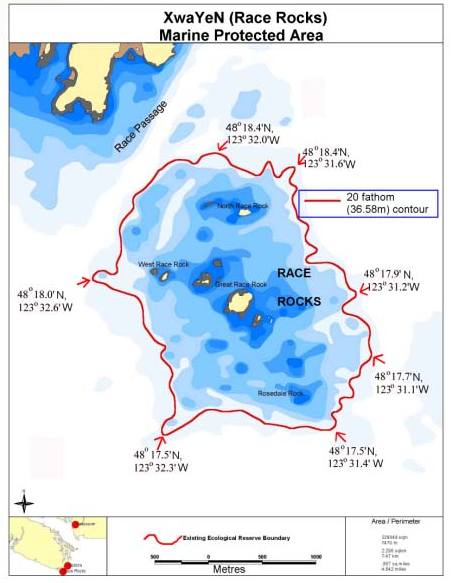
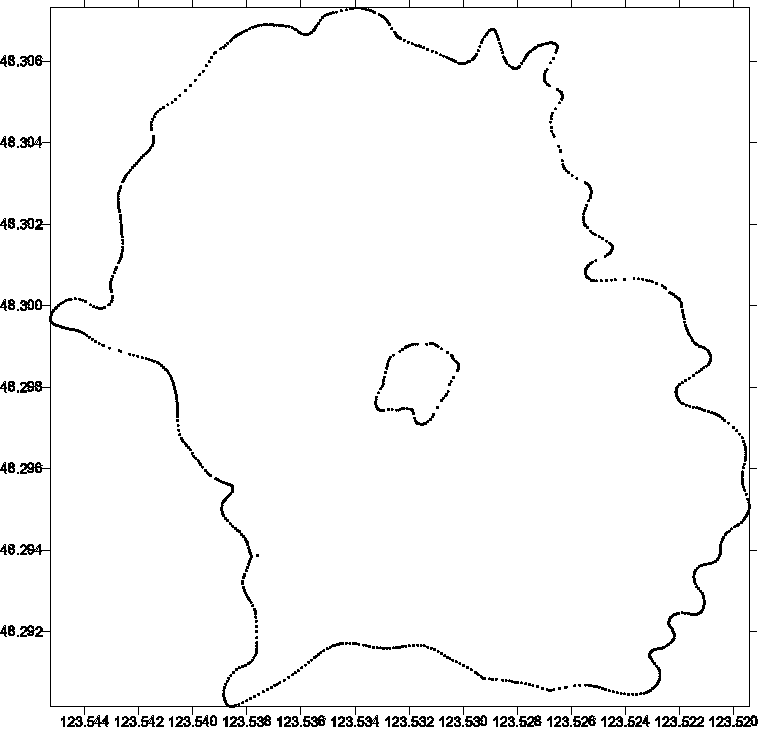 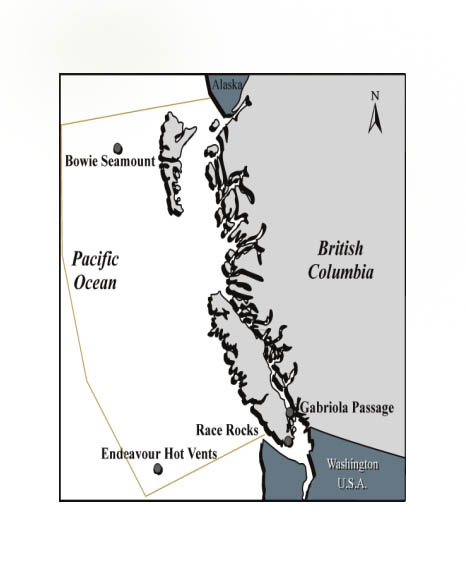
Appendix VII
Bibliography
BC Parks (1999). The Management Plan for the Race Rocks Ecological Reserve –Draft. Unpublished. 26pp.
Fisheries and Oceans Canada (1999). National Framework for Establishing and Managing Marine Protected Areas. 25pp
Fletcher, G. (1999). The Race Rocks Ecological Overview.
Governments of Canada and British Columbia (1998). Marine Protected Areas – A Strategy for Canada’s Pacific Coast. 28pp.
Kelleher, G. & A. Phillips (eds.) (1999). Guidelines for Marine Protected Areas. World Commission on Protected Areas of IUCN – The World Conservation Union. 28 pp.
Murgatroyd, L. (1999). Managing Tourism and Recreational Activities in Canada’s Marine Protected Areas: the Pilot Project at Race Rocks British Columbia. Dalhousie University graduate thesis.
Pakenham, M. (ed.) (2000). Race Rocks Advisory Board Management Recommendations for  ( Race Rocks) Marine Protected Area. Unpublished. 20pp. ( Race Rocks) Marine Protected Area. Unpublished. 20pp.
Pakenham, M. & K. Francis. (eds.) (2000). Regulatory Impact Assessment Statement – regulations to Designate  (Race Rocks) Marine Protected Area. Unpublished. 17 pp. (Race Rocks) Marine Protected Area. Unpublished. 17 pp.
Pakenham, M. & K. Francis. (eds.) (2000). Proposal to Designate  (Race Rocks) Marine Protected Area. Unpublished. 25pp. (Race Rocks) Marine Protected Area. Unpublished. 25pp. |

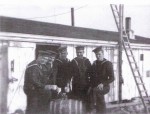



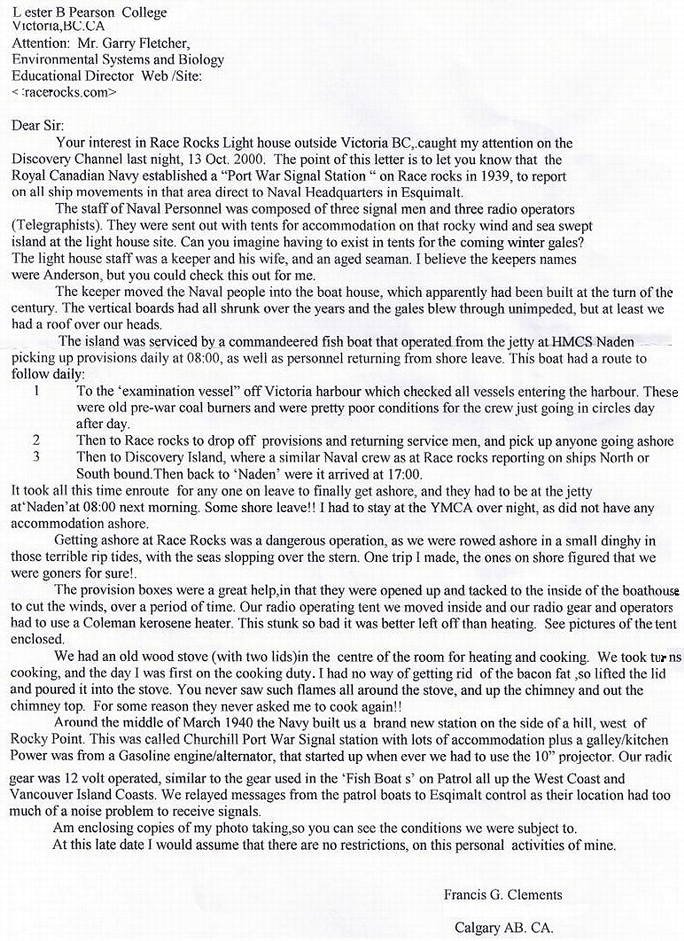
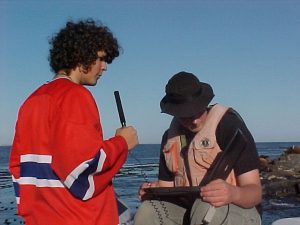

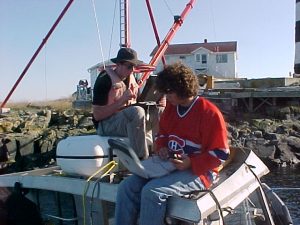
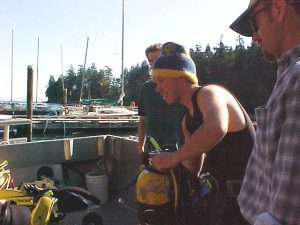
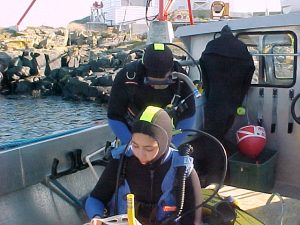
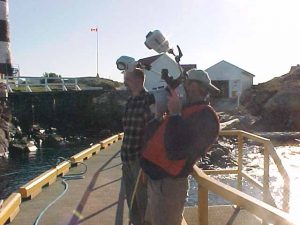
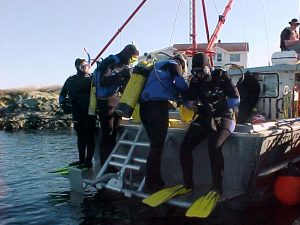
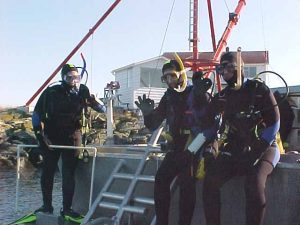
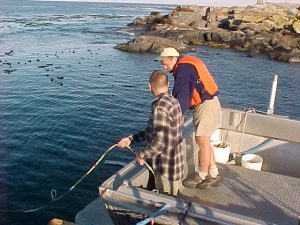



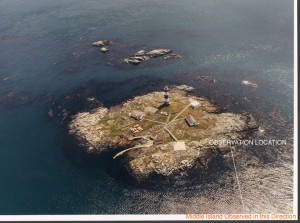
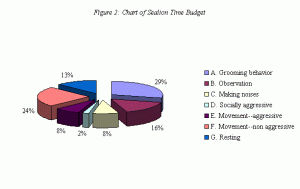 According to Figure 2 it appears that most of a sealion’s time, in comparison with other behavioral categories identified, is spent grooming (29%). This is followed by non-aggressive movement (24%), and then by observation (16%) and resting (13%). Both at 8% of the observed hour are aggressive movement and making noises. The least part of the sealion’s hour, 2%, was spent in socially aggressive behavior. This data would suggest that at this particular hour of observation, from 12:00pm to 1:00pm, sealions perched on rocks can be said to spend their time at various activities, but that the majority of time is spent grooming, moving non-aggressively (for better resting position), and resting. This behavior can be attributed to the fair weather and amount of sunlight available at this time of the day.This data does not really relate to the energy requirements of the species as the sealions were not observed to be feeding or hunting on or for their food.2 In fact from the data gathered, it might be possible to postulate that the sealions, during that one hour period, did not require much energy at all since they were mostly at rest, and at activities related to their own well being that were not related to hunting or eating. Similarily the data collected also does not shed that much light on the adaptive strategy of the sealion.3 The data collected can be interpreted to say that sealions are adapted to lying and resting on the land, with such motor capabilities and lung capabilities as needed, away from possible predatory sources in the sea.
According to Figure 2 it appears that most of a sealion’s time, in comparison with other behavioral categories identified, is spent grooming (29%). This is followed by non-aggressive movement (24%), and then by observation (16%) and resting (13%). Both at 8% of the observed hour are aggressive movement and making noises. The least part of the sealion’s hour, 2%, was spent in socially aggressive behavior. This data would suggest that at this particular hour of observation, from 12:00pm to 1:00pm, sealions perched on rocks can be said to spend their time at various activities, but that the majority of time is spent grooming, moving non-aggressively (for better resting position), and resting. This behavior can be attributed to the fair weather and amount of sunlight available at this time of the day.This data does not really relate to the energy requirements of the species as the sealions were not observed to be feeding or hunting on or for their food.2 In fact from the data gathered, it might be possible to postulate that the sealions, during that one hour period, did not require much energy at all since they were mostly at rest, and at activities related to their own well being that were not related to hunting or eating. Similarily the data collected also does not shed that much light on the adaptive strategy of the sealion.3 The data collected can be interpreted to say that sealions are adapted to lying and resting on the land, with such motor capabilities and lung capabilities as needed, away from possible predatory sources in the sea.


